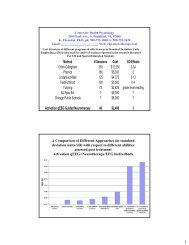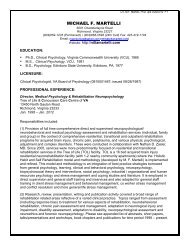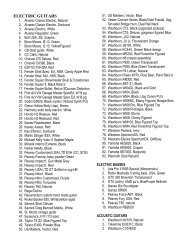Therapist NeuroBehavioral Competence Rating
Therapist NeuroBehavioral Competence Rating
Therapist NeuroBehavioral Competence Rating
You also want an ePaper? Increase the reach of your titles
YUMPU automatically turns print PDFs into web optimized ePapers that Google loves.
TREE OF LIFE<br />
SUPPORTED / TRANSITIONAL REHABILITATION SERVICES<br />
Behavioral<br />
Dimension<br />
Flexibility in<br />
Problem<br />
Solving<br />
Emotional/<br />
Behavioral<br />
Control<br />
Behavioral<br />
Reinforcement<br />
Skills<br />
Adaptive<br />
Expectancies<br />
Judgment<br />
& Decision<br />
Making<br />
Commitment<br />
to New Skills<br />
Development<br />
Appreciation<br />
for the "Big<br />
Picture"<br />
Therapeutic<br />
Attitude<br />
Personal &<br />
Job Related<br />
Stress Coping<br />
Skills<br />
<strong>Therapist</strong> <strong>NeuroBehavioral</strong> <strong>Competence</strong> <strong>Rating</strong> Scale<br />
High Compe- Good Adequate Deficient Incompetence<br />
tence <strong>Competence</strong> <strong>Competence</strong> <strong>Competence</strong><br />
Challenged (versus<br />
intimidated) by all<br />
problems & usually<br />
able to find effective<br />
ways to accomplish<br />
reasonable goals<br />
Always under-reacts &<br />
demonstrates selfcontrol<br />
of emotions &<br />
behavior at all times.<br />
Never Personalizes...<br />
Understand behaviors,<br />
shapes successive<br />
approximations and<br />
consistently employs<br />
effective behavior<br />
management skills to<br />
produce reasonable<br />
progress<br />
Always sets & adjusts<br />
reasonable, flexible<br />
client expectancies<br />
based on objective eval<br />
of strengths &<br />
weaknesses<br />
Exemplary awareness<br />
of impact of judgment<br />
&behaviors; never acts<br />
without foresight and<br />
planning<br />
Always seeks out<br />
opportunities for new<br />
learning & increasing<br />
and refining skills<br />
Consistently discriminates<br />
important versus<br />
peripheral issues and<br />
always prioritizes,<br />
adjusts & intervenes<br />
based on client needs<br />
Always reflects a goal<br />
focused & empathic<br />
attitude toward clients,<br />
families, staff &duties;<br />
interprets behavior in<br />
terms of the need for<br />
improved coping skills<br />
Consistently models<br />
adaptive, effortful<br />
coping skills/ strategies<br />
that are emulated by<br />
other staff, clients,<br />
families..<br />
Challenged by all<br />
problems; seeks assistance<br />
from others to<br />
find effective solutions<br />
to obstacles & interventions<br />
to facili- tate<br />
goal attainment<br />
Usually under-reacts to<br />
stress; can quickly<br />
retreat & regains<br />
control without losing<br />
control in crises<br />
Typically relies on<br />
positive reinforcement<br />
& shaping to guide<br />
client behavior, usually<br />
understands client<br />
behavior and always<br />
makes effort<br />
Maintains adaptive<br />
expectancies that are<br />
usually flexibly<br />
adjusted and consistent<br />
with patient strengths,<br />
weaknesses & stresses<br />
Good awareness of<br />
impact; typically acts<br />
with foresight and<br />
planning & very<br />
responsive to feedback<br />
Usually initiates skills<br />
growth & learning<br />
efforts; always follows<br />
through on feedback<br />
& suggestions of<br />
others<br />
Shows good discrimination<br />
and quick<br />
understanding with as<br />
needed information,<br />
seeking, clarification &<br />
feedback<br />
Interprets maladaptive<br />
behavior objectively,<br />
in terms of client's<br />
ineffective coping and<br />
interpersonal skills &<br />
always attempts to be<br />
objective & therapeutic<br />
Typically models<br />
adaptive, effortful<br />
coping skills/strategies<br />
that are often emulated<br />
by other staff, clients,<br />
families, etc.<br />
Seeks assistance from<br />
team members and<br />
demonstrates consistent<br />
improvement in<br />
areas of weakness<br />
Under-reacts on most<br />
occasions...quickly<br />
retreats and regroups<br />
after infrequent, very<br />
brief dyscontrol<br />
Usually: understands;<br />
relies on positive<br />
reinforcement and<br />
shaping; makes effort<br />
to understand effective<br />
reinforcement methods<br />
...confers with team<br />
members as needed<br />
Confers with team<br />
members to help<br />
develop reasonable<br />
client expectancies<br />
Confers with others &<br />
demonstrates increasingly<br />
effective<br />
judgment & decision<br />
making<br />
Always makes serious<br />
efforts to improve<br />
skills and follow<br />
through / benefit from<br />
feedback, suggestions<br />
Confers with team<br />
members to produce<br />
consistent improvements<br />
in understanding<br />
Seeks and utilizes<br />
information and<br />
constructive feedback;<br />
demonstrates success<br />
in adopting more therapeutic<br />
attitudes in weak<br />
areas<br />
Generally able, w/o too<br />
much delay, to ID own<br />
"wants", evaluate for<br />
reasonableness, &<br />
negotiate for adequate<br />
outcome<br />
Requires frequent<br />
feedback with little<br />
improvement, little<br />
benefit from feedback<br />
& little change in flexibility<br />
of approach<br />
Shows emotions that<br />
interfere with clinical<br />
effectiveness; requires<br />
frequent feedback with<br />
little improvement<br />
Is frequently condescending<br />
or uses<br />
backhanded remarks .<br />
(it's about time...why<br />
didn't you do before");<br />
too frequently employs<br />
negative reinforcement<br />
& punishment<br />
Typically requires<br />
feedback...usually slow<br />
and weak in adjusting<br />
expectancies to client<br />
strengths, weaknesses<br />
Requires feedback for<br />
increased awareness<br />
and to control<br />
judgments & behaviors<br />
Requires frequent<br />
feedback & prompting;<br />
resists changing old,<br />
familiar methods (from<br />
other seettings/models)<br />
Requires frequent<br />
feedback and shows<br />
slow acquisition of<br />
knowledge & skills<br />
Requires frequent<br />
feedback re: blaming<br />
client & interpreting<br />
behaviors in terms of<br />
personal effect &<br />
reactions; shows little<br />
attitude change<br />
Requires frequent<br />
feedback & shows<br />
little or slow improvement<br />
in personal stress<br />
management & coping<br />
skills<br />
©M.F. Martelli, Ph.D, P.J. Tiernan, R.N. & N.D. Zasler, MD: June, 1994<br />
Page 1<br />
Poor understanding/<br />
empathy for patient needs<br />
/motivations; intolerant of<br />
deviations from therapist<br />
way (or easy, expected,<br />
planned, convenient,"I<br />
told you" way)<br />
Frequently overreacts;<br />
demonstrates excesses of<br />
anger, excitement, etc. , in<br />
front of staff & clients<br />
&/or family members<br />
Seldom uses effective<br />
behavioral skills - e.g.<br />
impatiently tells Client<br />
/Family What to Do,<br />
without understanding or<br />
shaping & gets angry,<br />
punishes & blames them<br />
for failures<br />
Sets rigid expectancies<br />
without understanding<br />
client skills, weaknesses<br />
& stresses; doesn't adjust<br />
expectancies & ruins<br />
therapy elationships<br />
"Badmouths" or<br />
complains about staff or<br />
clients or personal<br />
problems or frustrations in<br />
public<br />
Defensive, resistant...<br />
complaining, blaming &<br />
indifferent...fails to<br />
develop more effective<br />
skills<br />
Lets pursuit of details and<br />
"little tasks" derail efforts<br />
toward primary areas of<br />
importance to client<br />
development/ progress<br />
Complains, gossips,<br />
resents, resists, blames &<br />
models negative attitudes<br />
(resentment, helplessness,<br />
burden, etc.) to<br />
client/ families and/or<br />
staff<br />
Consistently mismanages<br />
personal frustrations;<br />
blames, feel helpless and/<br />
or disinterested; models<br />
poor general stress &<br />
problem-solving skills
TREE OF LIFE<br />
SUPPORTED / TRANSITIONAL REHABILITATION SERVICES<br />
<strong>Therapist</strong> <strong>NeuroBehavioral</strong> <strong>Competence</strong> Scale (Self-<strong>Rating</strong> Form)<br />
INSTRUCTIONS: Please Rate Yourself Using the Following adapted Behavioral <strong>Competence</strong> <strong>Rating</strong> Scale. Attached is the Complete<br />
Behavioral <strong>Competence</strong> <strong>Rating</strong> Scale, including reference descriptors for each category. When you are finished, please complete the<br />
scoring by adding the total # of points (from 1 to 5 for each of nine [9] Behavioral Dimensions) and then computing an average<br />
(i.e., total # of points/ 9)<br />
Behavioral<br />
Dimension<br />
Flexibility in<br />
Problem<br />
Solving<br />
Emotional/<br />
Behavioral<br />
Control<br />
Behavioral<br />
Reinforcement<br />
Skills<br />
Adaptive<br />
Expectancies<br />
Judgment<br />
& Decision<br />
Making<br />
Commitment<br />
to New Skills<br />
Development<br />
Appreciation<br />
for the "Big<br />
Picture"<br />
Therapeutic<br />
Attitude<br />
Personal &<br />
Job Related<br />
Stress Coping<br />
Skills<br />
High <strong>Competence</strong><br />
5<br />
Total # Points: ________<br />
Average Score:________<br />
(Total/9)<br />
5<br />
5<br />
5<br />
5<br />
5<br />
5<br />
5<br />
5<br />
Good<br />
<strong>Competence</strong><br />
4<br />
4<br />
4<br />
4<br />
4<br />
4<br />
4<br />
4<br />
4<br />
Adequate<br />
<strong>Competence</strong><br />
3<br />
3<br />
3<br />
3<br />
3<br />
3<br />
3<br />
3<br />
3<br />
Deficient<br />
<strong>Competence</strong><br />
2<br />
©M.F. Martelli, Ph.D, P.J. Tiernan, R.N. & N.D. Zasler, MD: June, 1994<br />
Page 2<br />
2<br />
2<br />
2<br />
2<br />
2<br />
2<br />
2<br />
2<br />
Incompetence<br />
1<br />
1<br />
1<br />
1<br />
1<br />
1<br />
1<br />
1<br />
1
TREE OF LIFE<br />
SUPPORTED / TRANSITIONAL REHABILITATION SERVICES<br />
<strong>Therapist</strong> <strong>NeuroBehavioral</strong> <strong>Competence</strong> <strong>Rating</strong> Scale (Supervisor Form)<br />
INSTRUCTIONS: Please Rate _______ Using the Following adapted Behavioral <strong>Competence</strong> <strong>Rating</strong> Scale. Attached is the Complete<br />
Behavioral <strong>Competence</strong> <strong>Rating</strong> Scale, including reference descriptors for each category. When you are finished, please complete the<br />
scoring by adding the total # of points (from 1 to 5 for each of nine [9] Behavioral Dimensions) and then computing an average<br />
(i.e., total # of points/ 9)<br />
Behavioral High Compe- Good Adequate Deficient Incompetence<br />
Dimension<br />
Flexibility in<br />
Problem<br />
Solving<br />
Emotional/<br />
Behavioral<br />
Control<br />
Behavioral<br />
Reinforcement<br />
Skills<br />
Adaptive<br />
Expectancies<br />
Judgment<br />
& Decision<br />
Making<br />
Commitment<br />
to New Skills<br />
Development<br />
Appreciation<br />
for the "Big<br />
Picture"<br />
Therapeutic<br />
Attitude<br />
Personal &<br />
Job Related<br />
Stress Coping<br />
Skills<br />
tence<br />
Total # Points: ________<br />
Average Score:________<br />
(Total/9)<br />
5<br />
5<br />
5<br />
5<br />
5<br />
5<br />
5<br />
5<br />
5<br />
<strong>Competence</strong><br />
4<br />
4<br />
4<br />
4<br />
4<br />
4<br />
4<br />
4<br />
4<br />
<strong>Competence</strong><br />
3<br />
3<br />
3<br />
3<br />
3<br />
3<br />
3<br />
3<br />
3<br />
<strong>Competence</strong><br />
2<br />
©M.F. Martelli, Ph.D, P.J. Tiernan, R.N. & N.D. Zasler, MD: June, 1994<br />
Page 3<br />
2<br />
2<br />
2<br />
2<br />
2<br />
2<br />
2<br />
2<br />
1<br />
1<br />
1<br />
1<br />
1<br />
1<br />
1<br />
1<br />
1
Competency<br />
Understand and Apply: BEHAV-<br />
IOR IS COMMUNICATION<br />
Understand and consistently<br />
utilize Habit Retraining Model<br />
Avoid pejorative labels;<br />
Reframe to desired behavior<br />
Utilizes redirection and<br />
distraction to de-escalate<br />
Consistently follow behavioral<br />
protocols<br />
Understands / utilizes ABC’s of<br />
Behavior<br />
MODEL calm, controlled,<br />
respectful behavior<br />
(UNDER-REACT)<br />
Avoid argument, criticism,<br />
disrespect, displays of<br />
frustration<br />
Utilize “Mirroring” Technique<br />
(and others) to model and<br />
teach self control strategies<br />
Keep explanations clear and<br />
simple<br />
Utilize strategies (e.g., “4<br />
E’s”) to improve<br />
communication<br />
Utilize relaxation techniques as<br />
directed<br />
Understand, apply, and<br />
encourage “5 Commandments”<br />
Minimize episodic dyscontrol<br />
by controlling “Triggers”<br />
Recognize signs of agitation &<br />
make environmental changes<br />
as indicated (UNDER-REACT)<br />
Understand and apply Neurobehavioral<br />
<strong>Competence</strong> Scale<br />
(NSC)<br />
Tree Of Life Services, Inc.<br />
Neurobehavioral Competencies (Draft)<br />
How Assessed<br />
Date<br />
Page 4<br />
Comment<br />
Follow Up
Concussion Care Centre of Vrginia, LTD 10120 West Broad Street, Suites G & H, Glen Allen, VA 23060<br />
Habit Retraining Model: Promoting Rehabilitation<br />
Through Progressive Goal Achievement<br />
By Mike Martelli, Ph.D.<br />
Although the brain cells present when original learning takes place,<br />
and the stored knowledge that sustains important learned habits, can be<br />
erased by injury or illness, the ability to re-learn is seldom destroyed.<br />
Importantly, human beings are the greatest learning organisms ever to<br />
roam the earth. While animals are controlled by instincts, human behavior<br />
is driven by complex learning and the establishing of very complex habits.<br />
From the time of birth, almost everything that humans do is learned.<br />
Everyday functioning becomes increasingly sophisticated through the<br />
construction of a complex sequence of complex habits which are built on<br />
top of more basic habits. The complex behaviors that make up the<br />
average humans everyday behaviors are performed efficiently and<br />
automatically because of a hierarchy of habits.<br />
Through converting repeated behaviors into habits, complex behaviors<br />
are performed automatically, freeing up concentration, energy and effort for<br />
other tasks. However, some of even the most basic habits are weakened<br />
or erased, everyday abilities and routines can be seriously disrupted and<br />
efficiency lost. What was once automatic and effortless can require the<br />
same effort it took before efficient ways of performing any of the<br />
components of daily activities were learned. Fortunately, even if very basic<br />
and important learned habits are erased, newly learned habits can be<br />
developed as replacements.<br />
Importantly, we know what is required for both learning and<br />
relearning. Further, we are discovering that the most important variables<br />
relating to how much can be relearned, and how many habits can be<br />
replaced, are, in fact, our attitudes and expectancies. These attitudes can<br />
promote and guide re-establishment of new habits or thwart them.<br />
If we think we can't learn, if we think only the old learning/ way of<br />
knowing how to do things are sufficient, or if we think that only children<br />
can or should learn, then we will undermine relearning. Many attitudes<br />
can undermine relearning and these represent rehabilitation poisons.<br />
The essential ingredients for learning / relearning can be summarized<br />
as the 3 P's: (1) Plan; (2) Practice; (3) Promoting attitude.<br />
v The (1) Plan is a strategy or design for stepwise progress toward a<br />
desired outcome. Most plans are based on task analyses, or breaking<br />
seemingly complex tasks down into simple component steps, and<br />
proceeding in a list wise fashion. Clearly, the more specific, concrete,<br />
and obvious, the more likely the plan will work.<br />
v (2) Practice, or repetition is the cement for learning which makes<br />
complex and cumbersome and boring tasks more automatic and<br />
effortless. With practice and repetition, even complex tasks become<br />
automatic and habitual. That is, a habit, or automatic robots,<br />
performs the tasks for us without special effort, energy, concentration,<br />
memory, and so on.<br />
v (3) A Promoting or facilitative attitude provides the motivation that<br />
fuels persistence and mobilization of energy necessary for accomplishment<br />
of a progressive series of desirable but challenging goals.<br />
Importantly, the greatest obstacle to learning or relearning is the<br />
redirection of energy away from goal directed activity and toward<br />
debilitating activity. Some of the most potent relearning or rehabilitation<br />
debilitating attitudes, or poisons, are depression, anger and resentment,<br />
feelings of victimization, fear, and inertia. These take our energy away<br />
from relearning and put it somewhere else. Relearning is challenging, but<br />
can become impossible in the presence of significant internal obstacles.<br />
In an attempt to summarize the adaptive, facultative, or rehabilitation<br />
promoting attitudes characterized by rehabilitation patients who have<br />
accomplished remarkable progress despite insurmountable odds, the "Five<br />
Commandments of Rehabilitation" has been devised. These commandments<br />
serve as a prescription for rehabilitation achievement.<br />
Notably, the envisioning of a progressively more desirable future is the<br />
guiding principle, or magnet, that pulls persons to their goals. To the<br />
extent that one focuses on the vision of a desirable future, breaks progress<br />
down into small, progressive steps, and develops facilitative habits,<br />
incremental movement toward desired goals can be expected. Importantly,<br />
patterns of interpreting events, and expectancies about how things will turn<br />
out, represent predictions of the future. Habitual patterns of expecting<br />
failure or dissatisfaction, or mistreatment, and habitual patterns of<br />
becoming depressed, or angry, or fearful, etc., are debilitative habits that<br />
help drag persons toward failure. In contrast, the single best remedy, or<br />
antidote, is a graduated successes, self-esteem habit. This facilitative habit<br />
is broken down and presented in the Commandments of Rehabilitation.<br />
Making accurate comparisons, learning new ways to do old things, building<br />
one self up and employing positive self-coaching, and viewing rehabilitation<br />
as a series of small steps each requiring celebration, are some of the<br />
important prescriptions offered by "the commandments". The<br />
antidotes included in the "Five Commandments of Rehabilitation" are the<br />
medicines that interrupt the rehabilitation poison cycles. Energy will<br />
multiply in a cyclical fashion. If it proceeds in a negative direction, more<br />
and more energy will be robbed from the healing reserve, wasted in<br />
poisonous attitudes and made unavailable for relearning and<br />
accomplishment. For example, a depression habit in response to physical<br />
losses can reduce activity and hence relearning, which will lead to more<br />
depression by depletion of brain chemicals that protect mood, and, in turn,<br />
lead to poorer progress and more reason to be depressed.<br />
Antidotes like the "Five Commandments", a positive vision of a<br />
gradually improved future, and planning and practicing compensatory<br />
behavioral self-control strategies serve to protect the healing reserve by<br />
inoculating persons against depression, anger, and destructive emotion.<br />
This ensures that energy and motivation will be available so that desired<br />
goals can persistently pursued, with each step of progress adding new<br />
energy, hope and effort for the next step. With the addition of task<br />
analyses and scheduling that help promote routines, energy is turned<br />
toward protecting your healing reserve, taking your antidotes, and letting<br />
your goals pull you toward a more desirable future. Remember, anything<br />
that is consistently repeated will become a habit. Therefore, promote the<br />
attitude and activity routines will produce facilitative habits that turn your<br />
energy toward protecting your attitudes, taking your antidotes, and letting<br />
your healing reserve pull you like a magnet toward your goals.<br />
Medical Psychology/ Rehabilitation Neuropsychology Service Phone: 804- 270-5484








